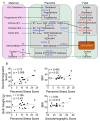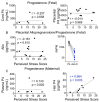Human Placenta Buffers the Fetus from Adverse Effects of Perceived Maternal Stress
- PMID: 33673157
- PMCID: PMC7918582
- DOI: 10.3390/cells10020379
Human Placenta Buffers the Fetus from Adverse Effects of Perceived Maternal Stress
Abstract
Maternal stress during pregnancy is linked to several negative birth outcomes. The placenta, a unique pregnancy-specific organ, not only nourishes and protects the fetus but is also the major source of progesterone and estrogens. As the placenta becomes the primary source of maternal progesterone (P4) and estradiol between 6-9 weeks of gestation, and these hormones are critical for maintaining pregnancy, maternal stress may modulate levels of these steroids to impact birth outcomes. The objective was to test whether maternal perceived stress crosses the placental barrier to modulate fetal steroids, including cortisol, which is a downstream indicator of maternal hypothalamic-pituitary-adrenal (HPA) axis regulation and is associated with negative fetal outcomes. Nulliparous women, 18 years or older, with no known history of adrenal or endocrine illness were recruited during their third trimester of pregnancy at the University of California San Francisco (UCSF) Mission Bay hospital obstetrics clinics. Simultaneous measurement of 10 steroid metabolites in maternal (plasma and hair) and fetal (cord blood and placenta) samples was performed using tandem mass spectrometry along with assessment of the perceived stress score and sociodemographic status. While the maternal perceived stress score (PSS) and sociodemographic status were positively associated with each other and each with the body mass index (BMI) (r = 0.73, p = 0.0008; r = 0.48, p = 0.05; r = 0.59, p = 0.014, respectively), PSS did not correlate with maternal or fetal cortisol, cortisone levels, or fetal birth weight. Regardless of maternal PSS or BMI, fetal steroid levels remained stable and unaffected. Progesterone was the only steroid analyte quantifiable in maternal hair and correlated positively with PSS (r = 0.964, p = 0.003), whereas cord estradiol was negatively associated with PSS (r = -0.94, p = 0.017). In conclusion, hair progesterone might serve as a better marker of maternal stress than cortisol or cortisone and maternal PSS negatively impacts fetal estradiol levels. Findings have implications for improved biomarkers of stress and targets for future research to identify factors that buffer the fetus from adverse effects of maternal stress.
Keywords: birth outcomes; cortisol; hair steroids; mass spectrometry; perceived stress.
Conflict of interest statement
The authors declare no conflict of interest. The funders had no role in the design of the study; in the collection, analyses, or interpretation of data; in the writing of the manuscript; or in the decision to publish the results.
Figures







Similar articles
-
Maternal and fetal hypothalamic-pituitary-adrenal axes during pregnancy and postpartum.Ann N Y Acad Sci. 2003 Nov;997:136-49. doi: 10.1196/annals.1290.016. Ann N Y Acad Sci. 2003. PMID: 14644820 Review.
-
Prenatal maternal psychopathology and stress and offspring HPA axis function at 6 years.Psychoneuroendocrinology. 2019 Jan;99:120-127. doi: 10.1016/j.psyneuen.2018.09.003. Epub 2018 Sep 7. Psychoneuroendocrinology. 2019. PMID: 30223193
-
Associations of schizophrenia with the activities of the HPA and HPG axes and their interactions characterized by hair-based biomarkers.Psychoneuroendocrinology. 2024 Jul;165:107049. doi: 10.1016/j.psyneuen.2024.107049. Epub 2024 Apr 16. Psychoneuroendocrinology. 2024. PMID: 38657340
-
Maternal stress and placental function, a study using questionnaires and biomarkers at birth.PLoS One. 2018 Nov 15;13(11):e0207184. doi: 10.1371/journal.pone.0207184. eCollection 2018. PLoS One. 2018. PMID: 30439989 Free PMC article.
-
Placental corticotrophin-releasing hormone, local effects and fetomaternal endocrinology.Stress. 2001 Dec;4(4):219-33. doi: 10.3109/10253890109014747. Stress. 2001. PMID: 22432143 Review.
Cited by
-
Association between maternal adversity, DNA methylation, and cardiovascular health of offspring: a longitudinal analysis of the ALSPAC cohort study.BMJ Open. 2022 Mar 24;12(3):e053652. doi: 10.1136/bmjopen-2021-053652. BMJ Open. 2022. PMID: 35332037 Free PMC article.
-
Steroidomics of Pregnant Women at Advanced Age.Front Endocrinol (Lausanne). 2022 Feb 23;13:796909. doi: 10.3389/fendo.2022.796909. eCollection 2022. Front Endocrinol (Lausanne). 2022. PMID: 35282454 Free PMC article.
-
Maternal prenatal stress induces sex-dependent changes in tRNA fragment families and cholinergic pathways in newborns.Mol Psychiatry. 2025 Sep;30(9):4307-4319. doi: 10.1038/s41380-025-03011-2. Epub 2025 Apr 5. Mol Psychiatry. 2025. PMID: 40188313 Free PMC article.
-
DCTPP1 regulates oxidative stress homeostasis via AUF1 in human villous trophoblasts.Cell Death Discov. 2025 Aug 23;11(1):400. doi: 10.1038/s41420-025-02666-8. Cell Death Discov. 2025. PMID: 40849295 Free PMC article.
-
Prenatal stress increases corticosterone levels in offspring by impairing placental glucocorticoid barrier function.PLoS One. 2025 Jul 18;20(7):e0313705. doi: 10.1371/journal.pone.0313705. eCollection 2025. PLoS One. 2025. PMID: 40679963 Free PMC article.
References
-
- Ding X.X., Wu Y.L., Xu S.J., Zhu R.P., Jia X.M., Zhang S.F., Huang K., Zhu P., Hao J.H., Tao F.B. Maternal anxiety during pregnancy and adverse birth outcomes: A systematic review and meta-analysis of prospective cohort studies. J. Affect. Disord. 2014;159:103–110. doi: 10.1016/j.jad.2014.02.027. - DOI - PubMed
Publication types
MeSH terms
Substances
LinkOut - more resources
Full Text Sources
Other Literature Sources
Medical
Research Materials

